Armenia is a country known for its beautiful churches. It’s no surprise since it was the first nation to accept Christianity as a state religion, all the way back in 301 AD. It may not seem like it now, but this was quite innovative at the time! And since the beginning, Armenian churches have played a central part in the history of the country, and the daily lives of its people. It’s no surprise that most tours in Armenia will include quite a few stops at these impressive monasteries. So here are the top 10 churches in Armenia you have to see.
If you’re not so much into Armenian churches, that’s ok too, because Armenia has a lot more to offer as well! But if you want the full Armenian experience, make sure you check out a few of these amazing religious sites.
This article may contain affiliate/compensated links. For more information, please see our disclaimer here. We take all the efforts necessary to ensure the information included in this post is accurate, correct and current, sometimes, things just change! Travel information like opening hours, business operations and prices may change. If you find anything in this post that is incorrect or outdated, please let me know in the comments so I can update it for other readers. Cheers!
We love helping you plan amazing trips. If you need any of these services, consider booking them through our affiliate links. Without costing you anything extra, you will be helping support us so we can continue to write these blogs for you.
We thank you again for your continued support.
🏠 Find the perfect place to stay with Booking.com
✈️ Get the cheapest flights with Skyscanner
🚣 Book your favorite activities with Viator
💻 Make sure you have everything you need for your epic trip by checking our store on Amazon
Table of Contents
The architecture of Armenian churches
Most of the Armenian churches in Armenia were built in medieval times. The ones that were destroyed during wars and earthquakes have usually been rebuilt as per their original plan, with some modern touches. Although the Armenian churches built in different periods have distinct features, they also have quite a few common characteristics.
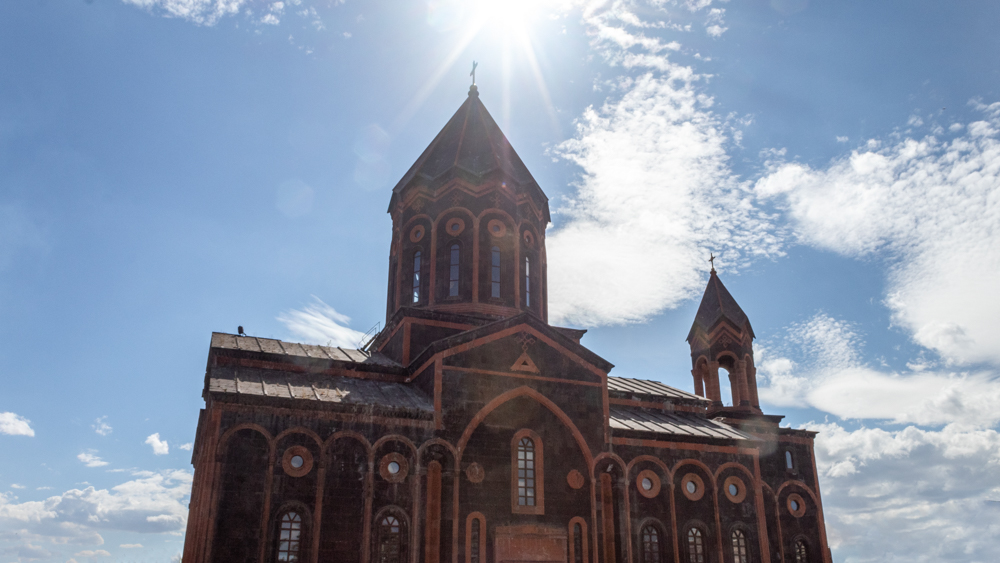
Here are some ways to spot typical Armenian churches. Their pointed domes resemble the volcanic funnel of Greater Ararat and are attached above arched ceilings. Often, the vertical accent of the whole building and its height exceed the length of the church. They are almost entirely made of stone and have arched, stone ceilings.
The 17 best cathedrals & churches in Armenia
It’s important to note that these churches and monasteries are not presented in any order. They all hold something unique and beautiful to discover. Although we’re not religious, it’s hard to deny the work and dedication the people who built these churches had. If nothing more, the churches are impressive works of architectural art.
With over 4,000 churches in Armenia, it’s hard narrowing it down to the very best and most impressive. These are the ones that really stuck with us, and that we still think about when we talk about our time in Armenia.
1. Khor Virap Monastery, the birthplace of Christianity in Armenia
This is probably one of the most important churches in Armenia. Its history is also quite impressive as it is said to be the birthplace of Christianity. The story dates back to 287 when Tiridates III was put on the throne by the Romans. His predecessor had been murdered by St Gregory’s father, but the young Gregory managed to escape to Cappadocia where he became a Christian.
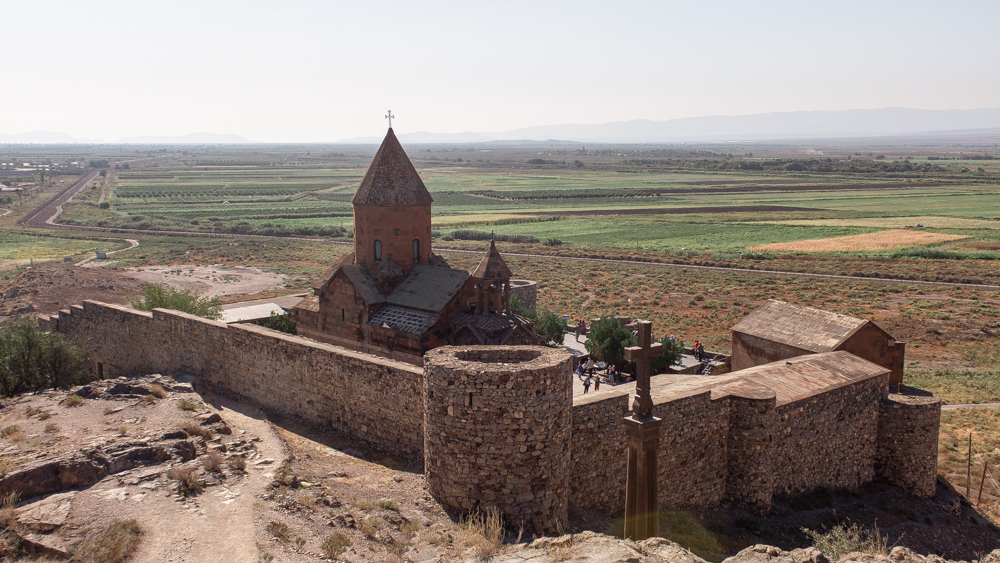
He then came back to Armenia to start converting others to the religion. This didn’t work out too well since Tiridates threw Gregory into an underground pit where he remained for thirteen years, surrounded by snakes, scorpions, and rats. You can actually go down into this pit when you visit Khor Virap. It’s tiny enough as it is, it’s hard to imagine what it was like back in his day!
The story says that God struck the King with a terrible illness. The King’s sister, obviously the wise one in the family, said that the best way to cure him was to release Gregory. As a result, the King miraculously recovered and converted to Christianity, along with his court. It was in 301 that Armenia was declared a Christian country.
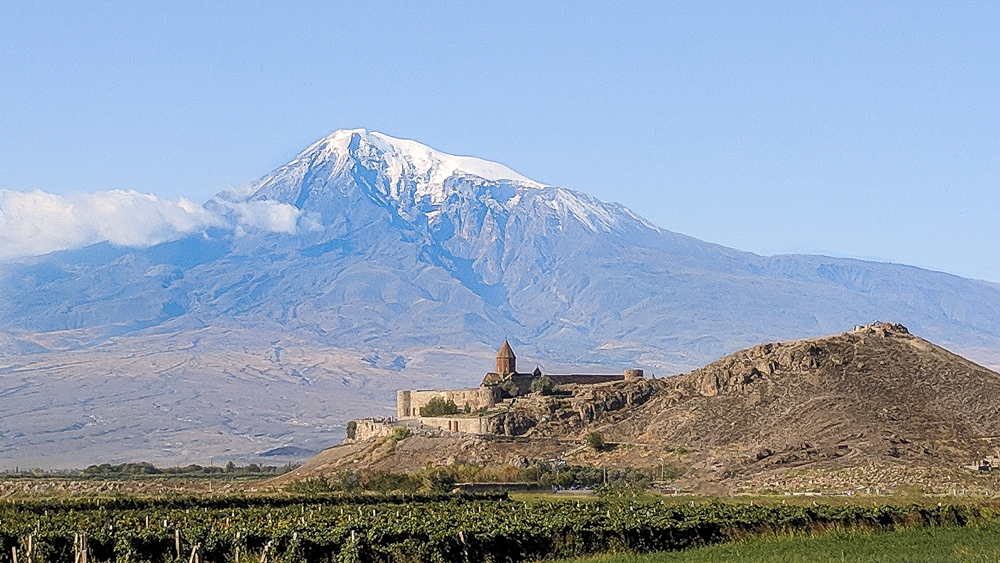
Not only is this church beautiful, but its surroundings are as well! Its backdrop is no other than the stunning Mount Ararat. This is probably the best spot to see this impressive mountain.
The Khor Virap monastery is a 7th-century Armenian monastery in the Ararat plain in Armenia, very close to the border with Turkey and the closest point in Armenia to Mount Ararat, the national symbol of Armenia. On a clear day, the view from there is breathtaking. This church is a great one to visit on a day trip from Yerevan, which you can combine with the next one on our list.
2. Noravank Monastery, a unique church in Armenia
Noravank, about 2 hours out of Yerevan, was built in the 13th century. The monastery is located in a narrow gorge made by the Darichay river, nearby the city of Yeghegnadzor. In the 13th–14th centuries, the monastery became a residence of the region of Syunik’s bishops and, consequently, a major religious and, later, cultural center of Armenia.
It’s a great example of the ornate architecture of the period. On the site, you will find three surviving churches, each decorated in intricate designs and religious reliefs, mainly created by Momik. He also carved many “khachkars”, typical Armenian religious monuments that usually consist of a cross surmounting a circular symbol.
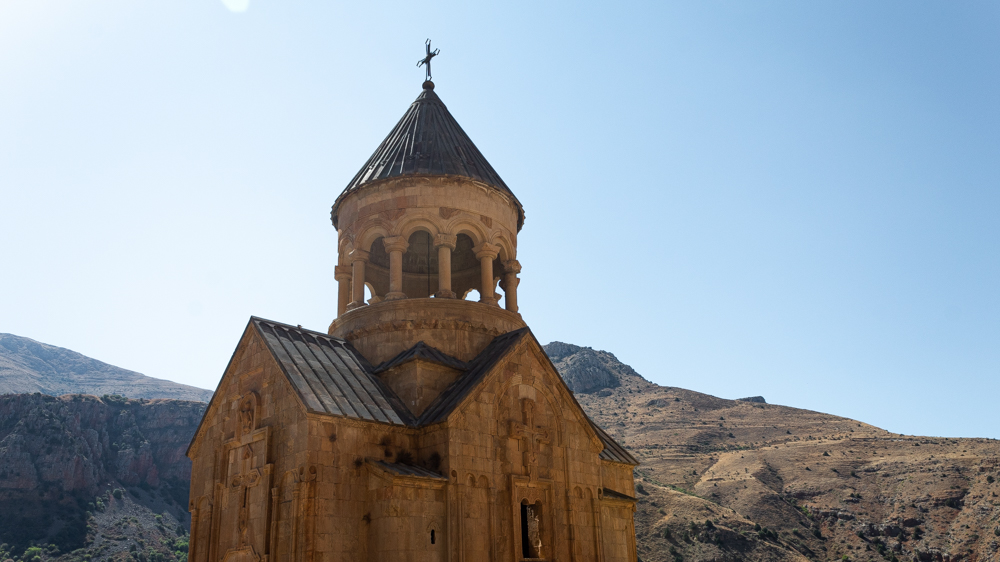
The monastery is best known for its two-story Surb Astvatsatsin (Holy Mother of God) church. You can climb up to the second level by a narrow stone-made staircase jutting out from the face of the building. Luckily, there is a rope to help you up.
The church is also set in the most beautiful place, up on a cliffside, surrounded by tall rock walls. This church is a great one to visit on a day trip from Yerevan, which you can combine with the previous one on our list.
3. Geghard Monastery, one of the most impressive monasteries in Armenia
The monastery of Geghard is probably one of the most impressive in Armenia. Most of the monuments here were built between the 4th and 13th centuries, and large parts were carved straight out the mountain it sits on.
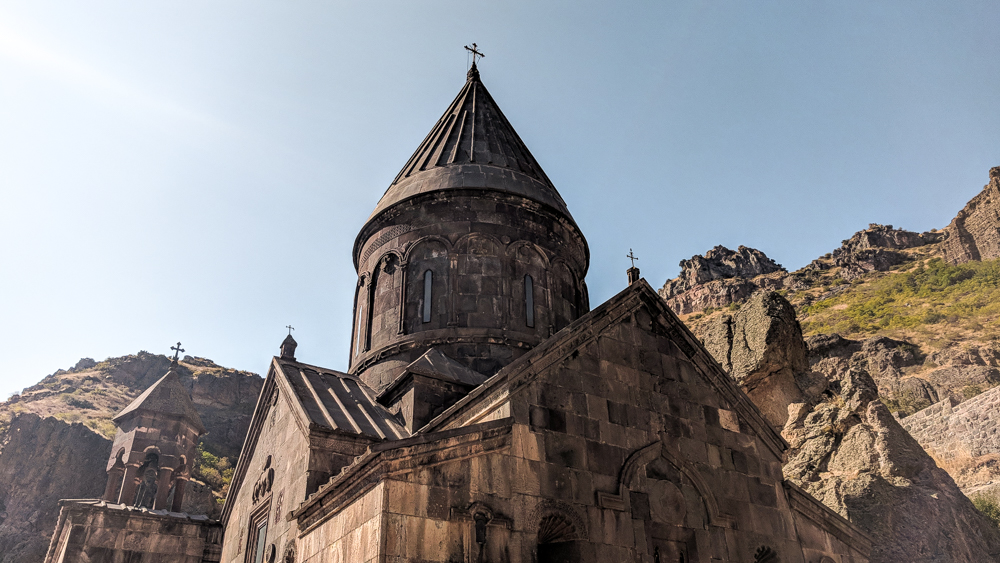
This beautiful complex of medieval buildings is surrounded by great natural beauty, at the entrance of the Azat Valley. With high cliffs that surround the northern side of the monastery, and a defensive wall that circles the rest. It’s clear to see why this medieval monastery is listed as a UNESCO World Heritage Site.
What makes Geghard even more special is that the spear, which had wounded Jesus at the Crucifixion, was allegedly brought to Armenia by Apostle Jude, and stored amongst many other relics at this church. The name “Geghard” actually means “spear”. But don’t expect to see the spear at the church, it has since been moved to Etchmiadzin.
Visiting Geghard is easy to do from Armenia’s capital. In fact, it’s a great day trip from Yerevan. You can easily combine your visit here with a visit to Garni temple. It’s a real treat for a day trip!
4. St Grigor Lusavorich cathedral in Yerevan, the largest Armenian church
This is the newest of the churches on this list. Its construction started in 1997 and was completed 4 years later, in 2001. The Saint Gregory the Illuminator Cathedral, which is also known as the Cathedral of Yerevan is currently the world’s largest cathedral of the Armenian Apostolic Church. It’s also the largest Armenian cathedral and is conveniently located in the central part of Yerevan, in the Kentron District.
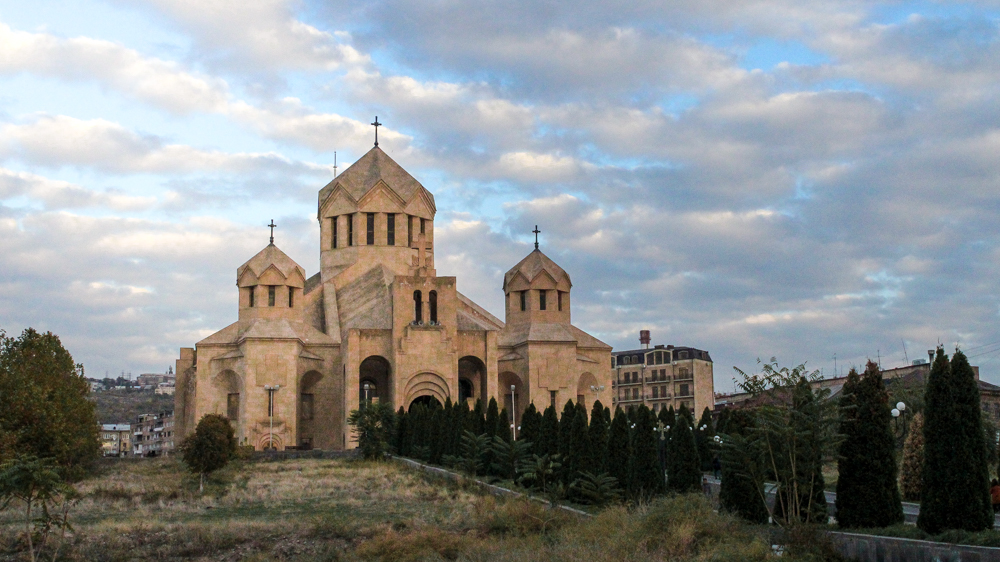
As if it wasn’t big enough, it’s also considered to be one of the largest religious buildings in the South Caucasus. It’s also home to the relics and holy remains of Saint Gregory the Illuminator, brought from Naples, in Italy. Make sure to go during the day, and at night. It looks quite different when it’s lit up!
If you head to the GUM Market from Republic Square, you won’t be able to miss this Armenian church. It’s also easy to get here from the Zoravar Andranik metro station.
5. Katokhike, the oldest, and smallest church in Yerevan
Katoghike Holy Mother of God Church is a small medieval church in the Kentron District of Yerevan, Armenia’s capital. According to the scripts carved on one of the walls of Katoghike Church, the surviving structure dates back to 1264. This makes it one of the oldest churches in Yerevan.
In 1936, the basilica of the Holy Mother of God was demolished under Soviet rule to make way for residential buildings and a linguistic institute on Sayat-Nova Avenue. During the demolition, the 13th-century church of Katoghike was discovered encased within the structure of the large basilica. After protests from archaeologists, the church was preserved. Many old khachkars (cross-stones) were found in the walls of the demolished church dating back to the 15th and 17th centuries.
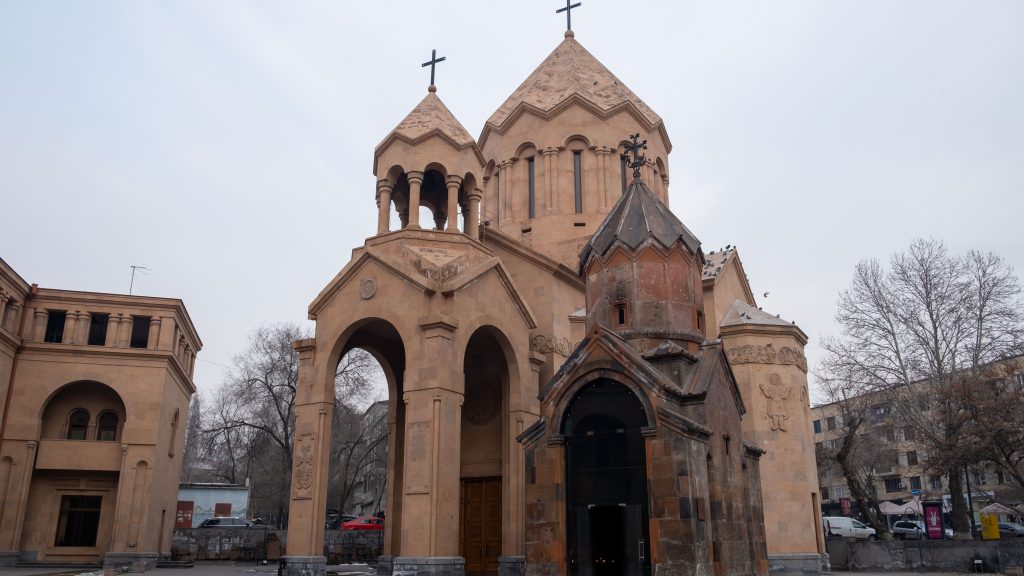
It was also discovered that the demolished basilica itself had been built on the foundations of an old church known as the Holy Mother of God. The hypothesis that this old church had existed was completely confirmed during the demolition of the Katoghike Church, when the southern and northern walls to which the two vestries were annexed were opened.
A new religious complex was constructed to the north of the church. The new complex includes a much bigger church, named after Saint Anna, and a building designated to serve as the Yerevan residence of the Catholicos.
In 2009, a ground blessing service was conducted for the construction of Saint Anna Church and the associated complex. It was only in 2015 that the Saint Anna Church was consecrated.
6. Saint Hovannes Mkrtich, a church in the oldest part of Yerevan
Saint John the Baptist Church or Surp Hovhannes Mkrtich is an active church in the oldest area of Yerevan called Kond. It was built on one of the highest parts of Kond district, in 1710. It was built in the place of a medieval Armenian church that was ruined after an earthquake. It was built with the help of the funds of a prominent man, Melik Aghamal. Like the other medieval churches, this is a three-nave basilica church.
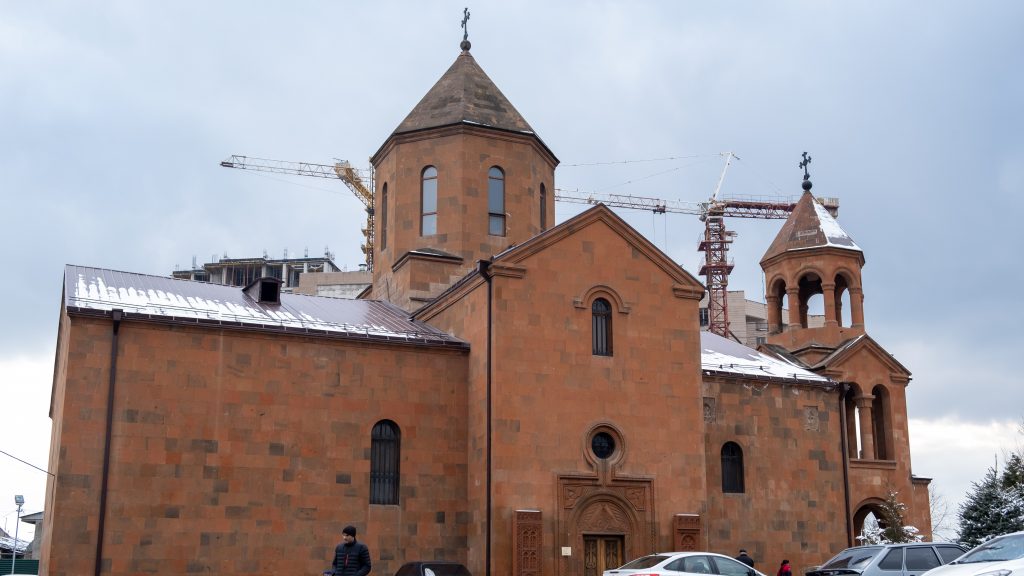
Concerned by the unattractive look of the church, in 1979, architect Rafael Israelyan presented a project for the reconstruction of the church. Although the plan was approved, the architect died the same year.
In the 1980s, the Church was entirely reconstructed and restored. The dome and the walls of the church were faced with tuff stone, and large-scale work was realized inside the church, including the addition of a story for the choir, and a bell tower.
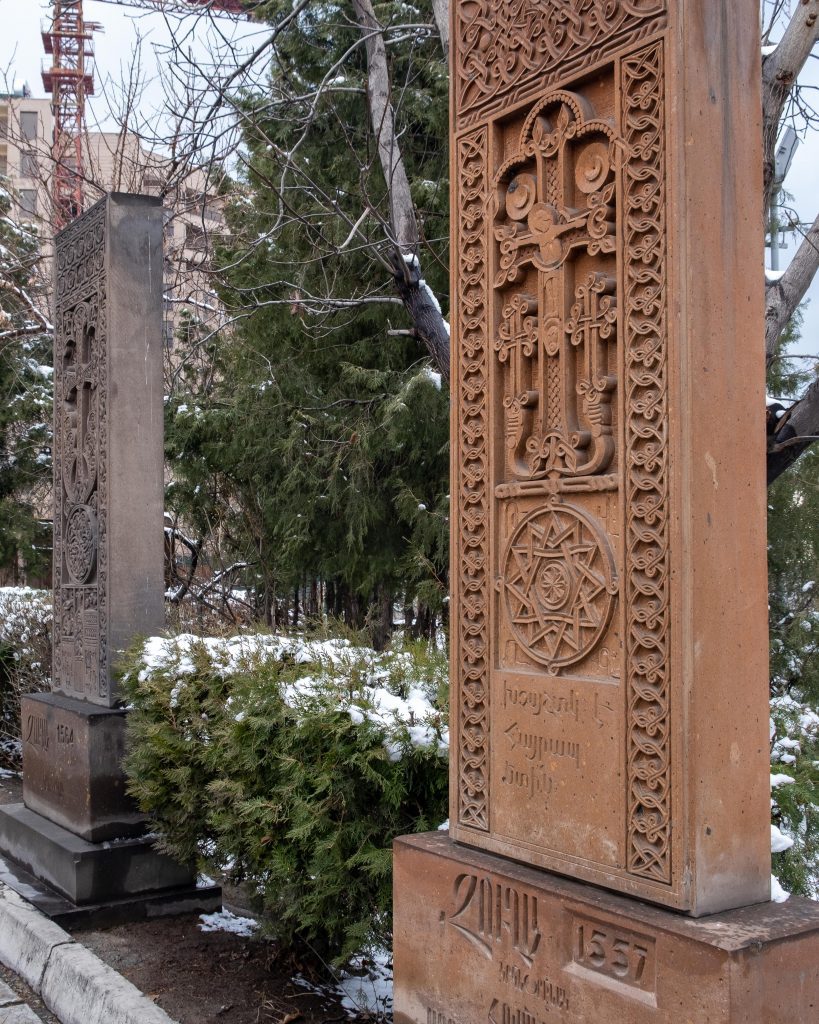
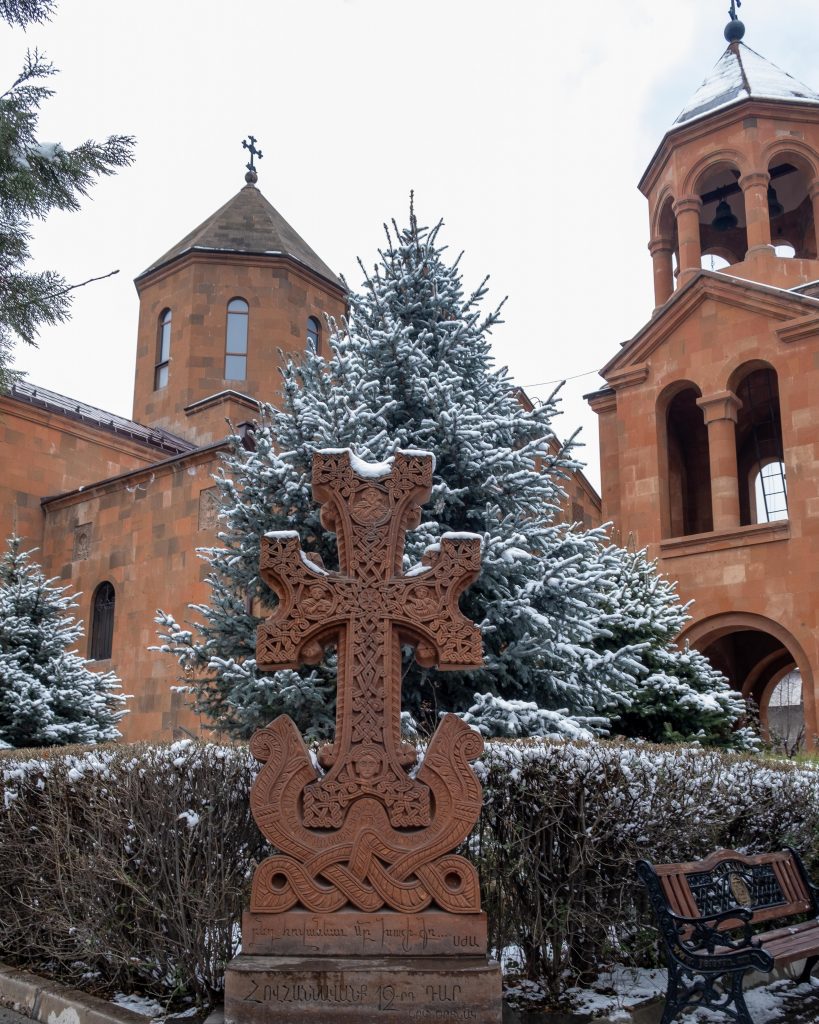
Today, it’s one of the few places you can check out khatchkars that are replicas of those that used to be found in the Old Djulfa cemetery. The khatchkars in Djulfa were the largest collection of medieval cross-stones found anywhere in the world. There were over 10,000 cross-stones, dating back to the 6th century, that were destroyed in 2005 by Azerbaijan’s government.
7. Tatev Monastery, one of the most impressive cathedrals in Armenia
Tatev monastery is probably the furthest to get to in Armenia. The route there will take about 3-4 hours from Yerevan, but it’s well worth it. Not only is Tatev a beautiful monastery, but it has a really cool mode of transportation to get there. The Wings of Tatev! This is the World’s longest reversible ropeway, measuring a whopping 5,752 m. The views from the tramway are just epic!
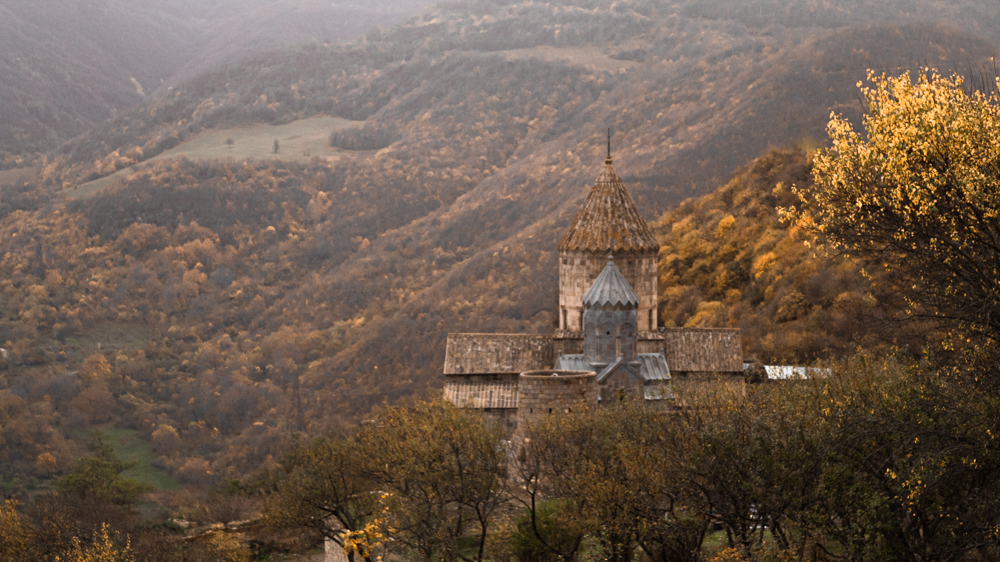
This monastery was built in the 9th century, on a large basalt plateau. The monastic complex stands on the edge of a deep gorge and offers spectacular views of the mountains and valleys.
Tatev played a significant role in history as a center of economic, political, spiritual and cultural activity. Back in the 14th and 15th centuries, it hosted one of the most important Armenian medieval universities, contributing to the advancement of science, religion, and philosophy, reproduction of books and development of miniature painting.
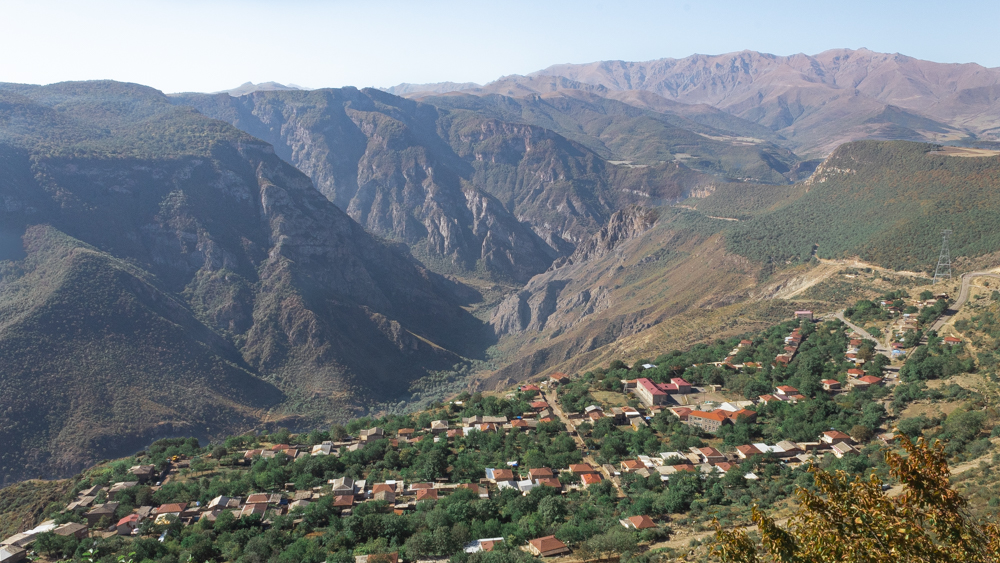
Today, parts of the monastery are under renovation to restore it to its past glory. The experience of getting to Tatev, combined with the beauty of the complex and the impressive surroundings makes it one of our favorites!
8. Etchmiadzin Armenian Apostolic Church, one of Armenia’s oldest churches
About 30 minutes outside of Yerevan, in the city of Vagharshapat, this cathedral is a very important landmark of the Armenian Apostolic Church. It’s basically like the Vatican for Armenians and is considered to be one of the first and oldest churches in Armenia and the whole world.
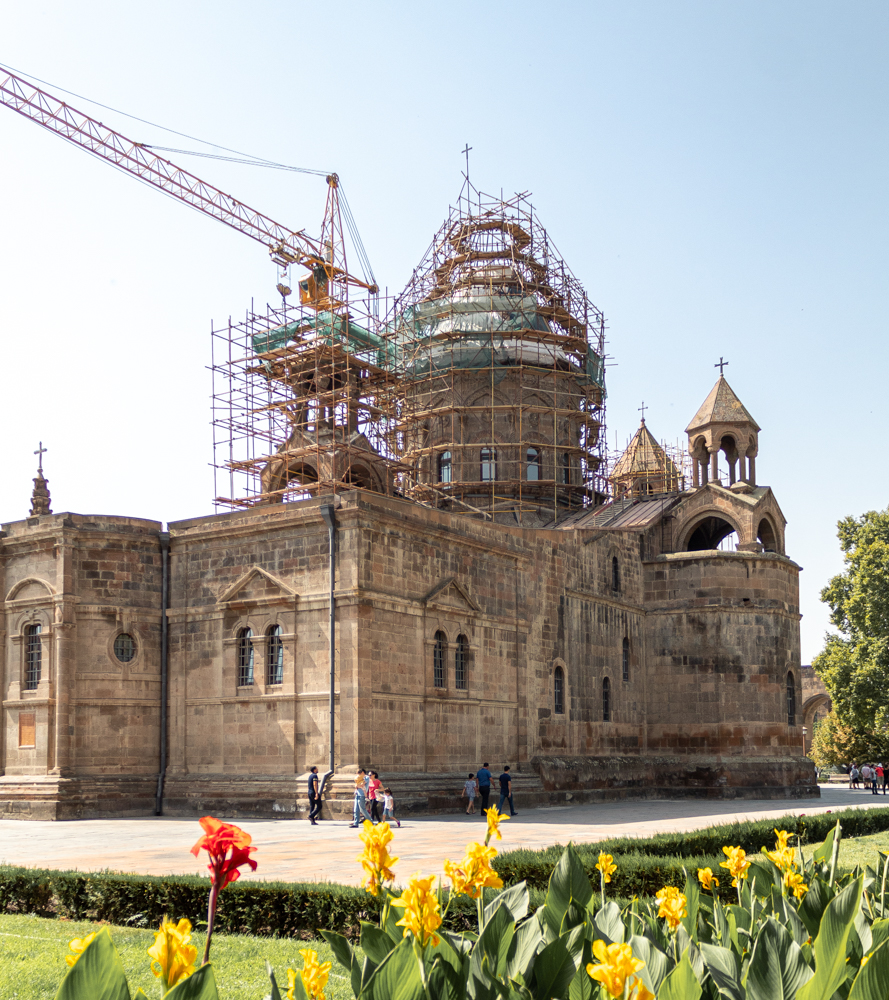
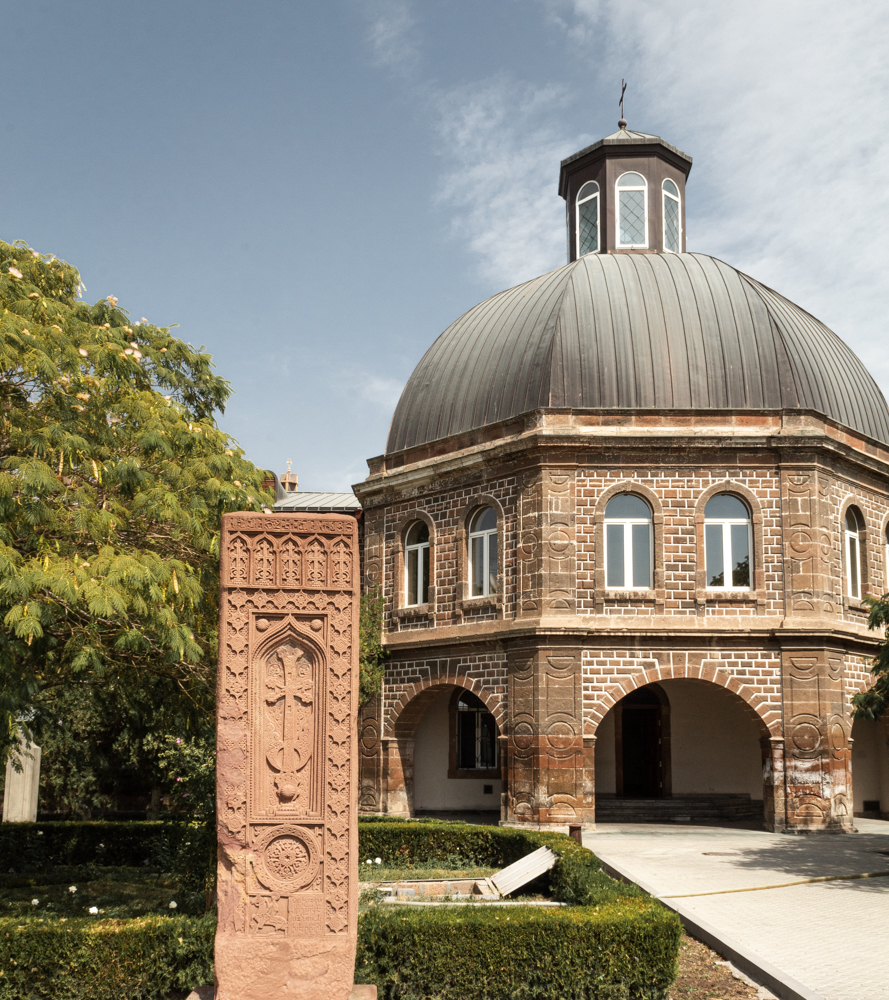
The original church was built in the early 4th century by Saint Gregory the Illuminator. We hope you guys remember who this guy is after everything we’ve mentioned about him!
It was believed that the church was built where Christ had struck the earth with a hammer. But after many archaeological studies, it was shown that beneath the cathedral, there is in fact, a Roman temple.
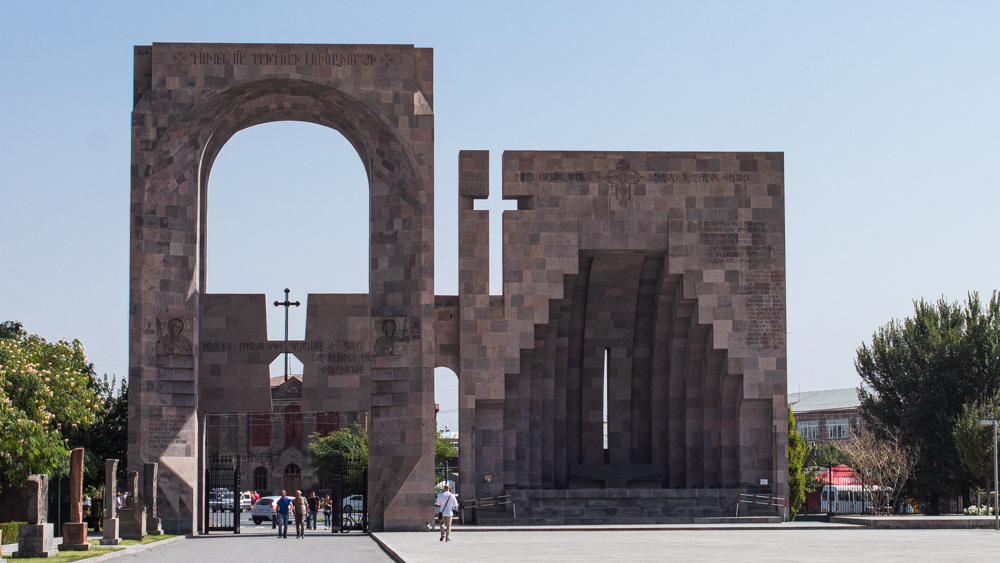
The shape and structure of Etchmiadzin are actually the blueprints for most Armenian churches that were built after it. The museum of the church is quite impressive to visit as well.
9. Sevanavank Monastery, the beautiful church by Lake Sevan
This is one of Armenia’s most visited churches, mainly because it’s set on the beautiful and beloved Lake Sevan. The monastic complex of Sevanavank is set high atop the peninsula of the Lake.
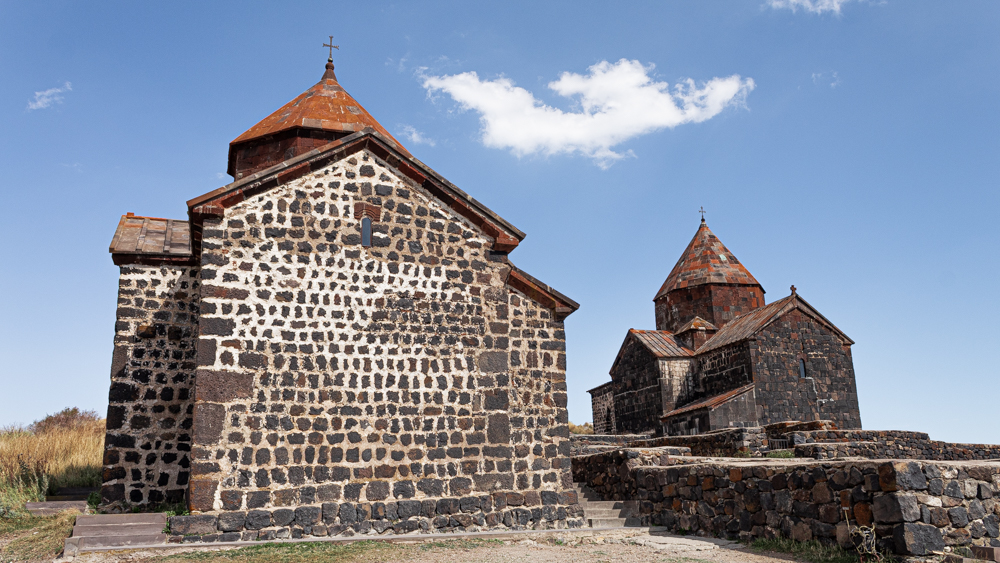
Fun fact (that’s not so fun): the monastery was initially set on top of an island, but because of the artificial draining of Lake Sevan during Stalin’s era, the island turned into a peninsula. The water levels dropped 20 meters, which is considerable (and a shame).
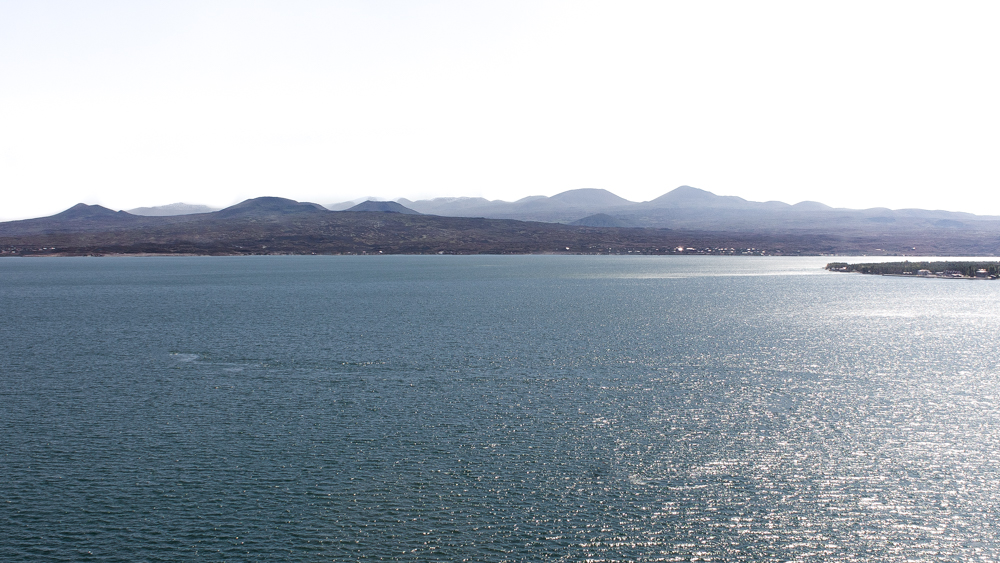
The church is small but really beautiful. It’s a short climb to get to it, but the views you get up there are really stunning!
10. Hayravank, a lesser known Armenian church on Lake Sevan
Hayravank Monastery is a 9th century Armenian monastery located along the southwest shore of Lake Sevan, in the Gegharkunik Province of Armenia. Most people don’t come to this church, which makes it perfect to visit. Usually, Sevanavank, mentioned above, is the most popular church along Lake Sevan.
The Hayravank monastic complex consists of a church, chapel, and gavit. Its name literally translates to Father’s monastery.
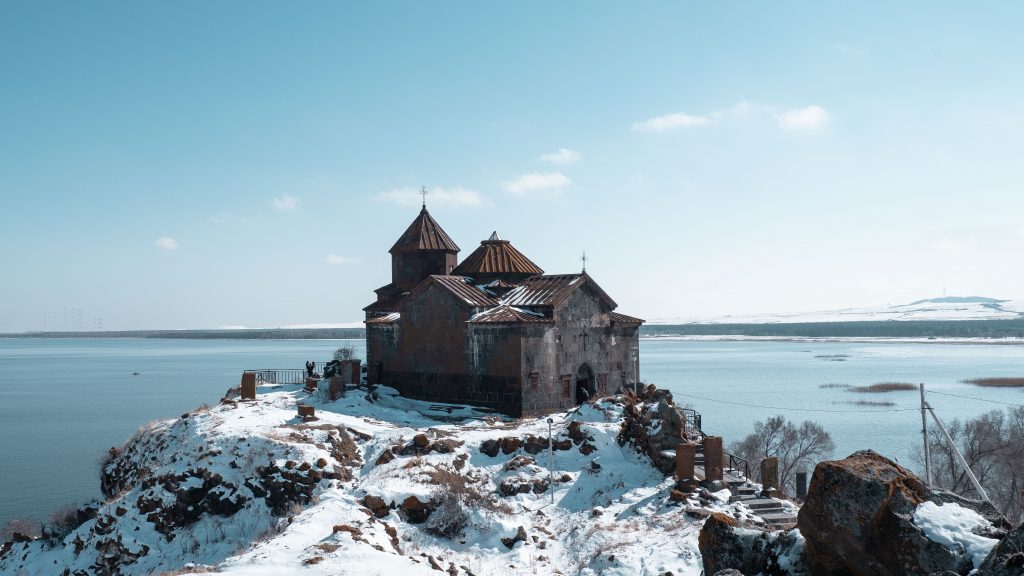
Surrounding the monastery are numerous khachkars and gravestones that are part of a small cemetery. To the northwest, a short distance from the monastery, are the remains of the Bronze Age through medieval fortification walls and foundations of a settlement. Nearby are also two Iron Age tombs.
A polished black vessel of the Early Bronze Age was discovered during archaeological excavations in the area. Weapons of metal and stone, tools, clay idols, numerous vessels, fireplaces, and two tombs, all from the Iron Age were discovered in the vicinity as well.
11. Haghartsin Monastery, a beautiful Armenian church in Dilijan
Built between the 10th and 13th centuries, Haghartsin is near Dilijan, about 2 hours outside of Yerevan. It’s actually situated in the Dilijan national park and is a stop on the Transcaucasian Trail, a long-distance hiking route.
Hagartsin’s name actually comes from the eagles who soar above it, as it means “games of eagles”. That’s probably why the image of this proud bird can be seen on its walls.
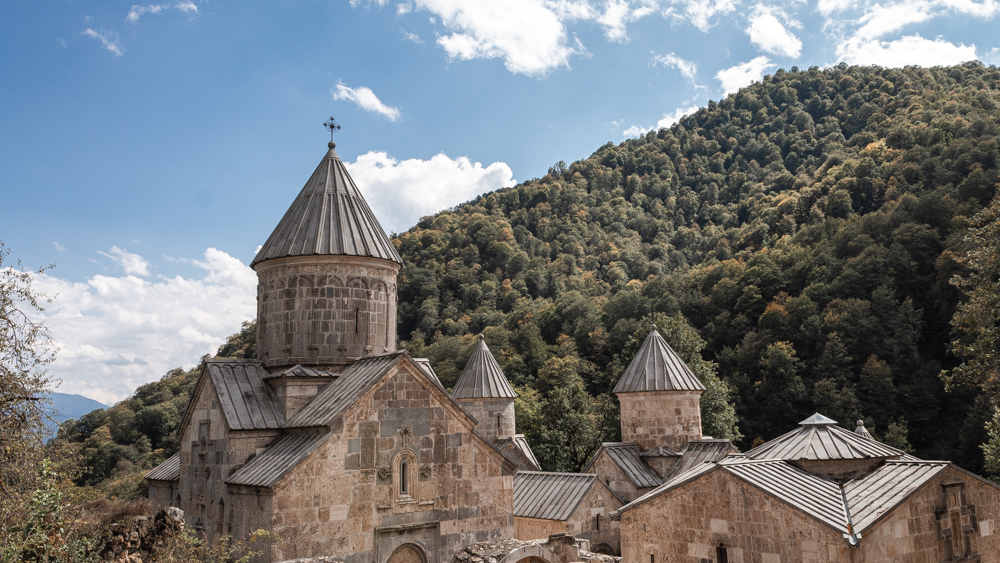
Sitting atop the canyon, Haghartsin is one of the most mysterious places in Armenia. On the site, you will find 3 churches, St. Gregory church (11th century), St. Astvatsatsin church (1281), St. Stepanos church (1244) as well as the 13th century chapel, the tomb of Bagratids (12th century), the refectory (1248) and various premises built in the 12th & 13th centuries.
Again, the surroundings of the church make it even more beautiful to discover. Make sure you walk around to get a full sense of how impressive this whole site is.
12. Ohanavank, an Armenian cathedral in a beautiful setting
Hovhannavank (Ohanavank) is an Armenian Apostolic Church monastery located in the village of Ohanavan in the Aragatsotn Province of Armenia. What makes this church so impressive, apart from its age, is its location. It sits atop a steep gorge, the Kasagh River canyon.
The monastery’s title comes from the combination of the name Hovhan (Armenian for Jonah) and the word “vank,” which in Armenian means “monastery.” The relics of Saint-John are said to be kept in the church.
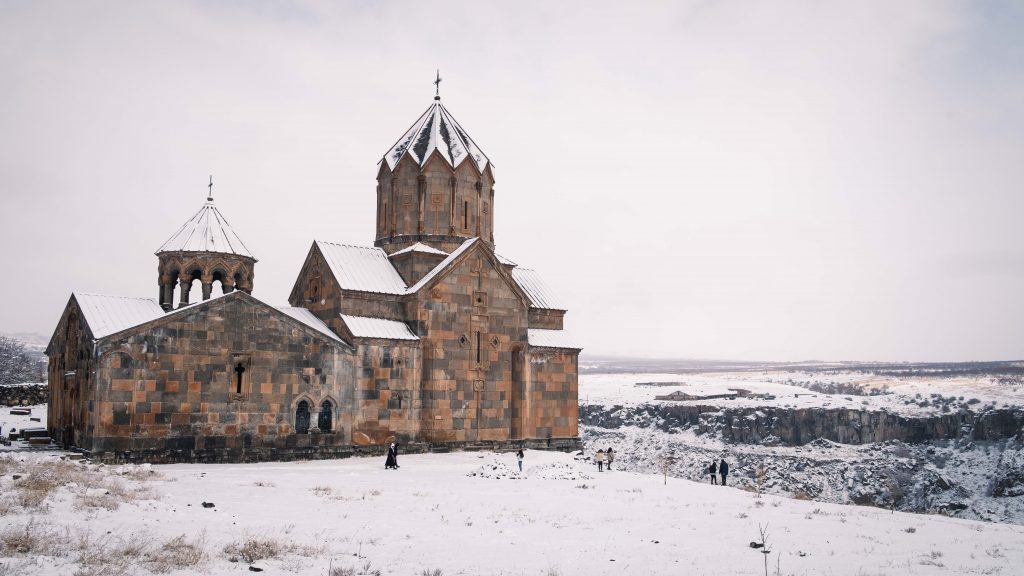
The oldest part of the monastery is the single nave basilica of St. Karapet (i.e. Holy Forerunner, John the Baptist). It was founded at the beginning of the fourth century by St. Gregory the Enlightener, who baptized Armenia into the world’s first Christian nation. Back in the day, it used to be the cultural and scholastic center, along with Saghmosavank.
13. Sahgmosavank, a church in Armenia worth seeing
Saghmosavank Monastery is a 13th century Armenian monastic complex located in the village of Saghmosavan in the Aragatsotn Province. It’s only 5 kilometers away from the previous church, Ohanavank, and it’s just as impressive, also sitting atop the precipitous gorge carved by the Kasagh river.
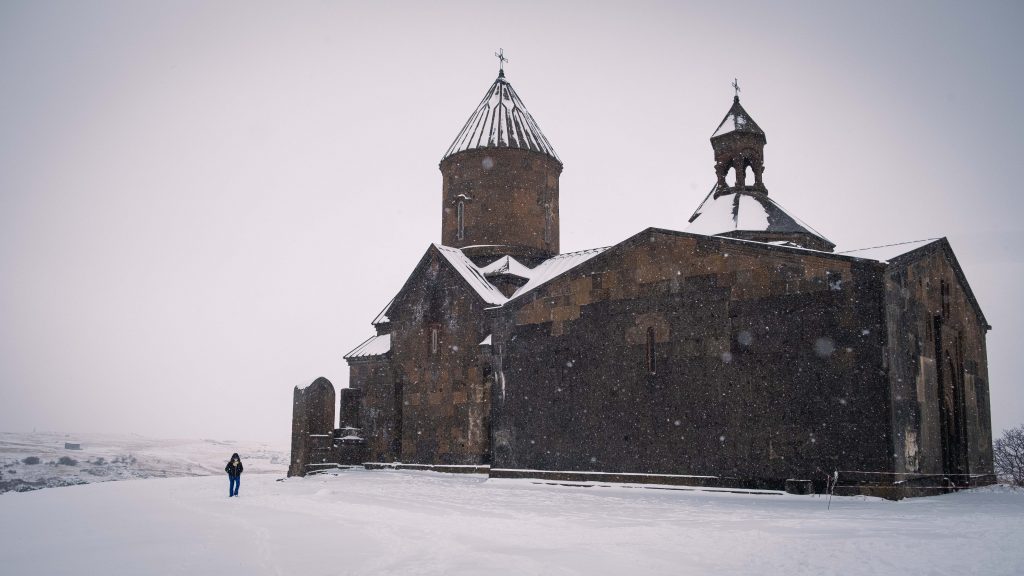
Saghmosavank means “monastery of the Psalms”. The silhouette of this church also dominates the adjacent villages and rises sharply against the background of the mountains crowned by Mount Aragats, which is visible on a clear day.
14. All Saviours Church, a must-see church in Gyumri
All Saviours Church is a 19th-century church in Gyumri, Armenia’s second-largest city. It’s located at the southern side of the Vartanants Square at the centre of the city. It was constructed between 1858 and 1872 and consecrated in 1873. The design of the church was derived from the architecture of the Cathedral of Ani, however, this is much larger than the Cathedral of Ani.
During the 1850s, an Armenian Catholic church and a Greek Orthodox church were built at the centre of Alexandropol-Gyumri. Feeling insulted by this fact, the devotees of the Armenian Apostolic Church (who constituted the majority of the city’s population) decided to build a new church right in the middle of the 2 churches. They wanted it to look larger and much more imposing than the others.
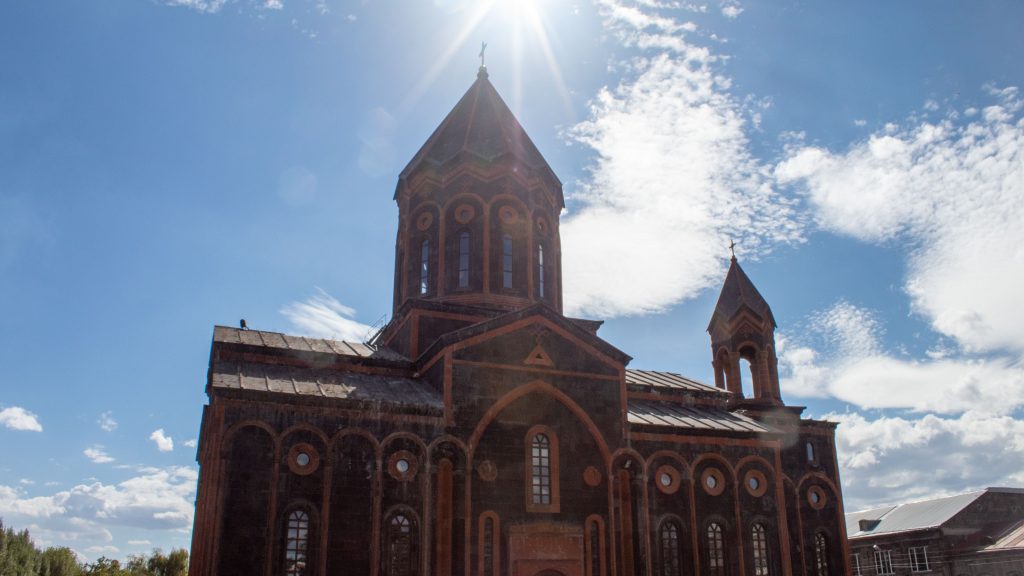
The construction of the church was launched in 1858 led by architect Tadeos Andikyan who was known as the master of masters. It was completed in 1872 and consecrated in 1873. The construction was fulfilled through the donations of the population of Alexandropol and the Drampyan family.
During the devastating 1988 earthquake, the Church of the All Saviours was severely damaged and an entire renovation process began in 2002. Although, the renovation is at its final stages and the church was expected to be reopened in 2015. However, at the time of writing, the church remains closed and is still under renovation.
15. Teghanyats monastery, an Armenian church in ruins, but worth hiking to
Teghenyats monastery is a 12th century monastery located north of Yerevan in the Teghenis Mountain Range. The monastery is located near Buzhakan village, in the Kotayk Province.
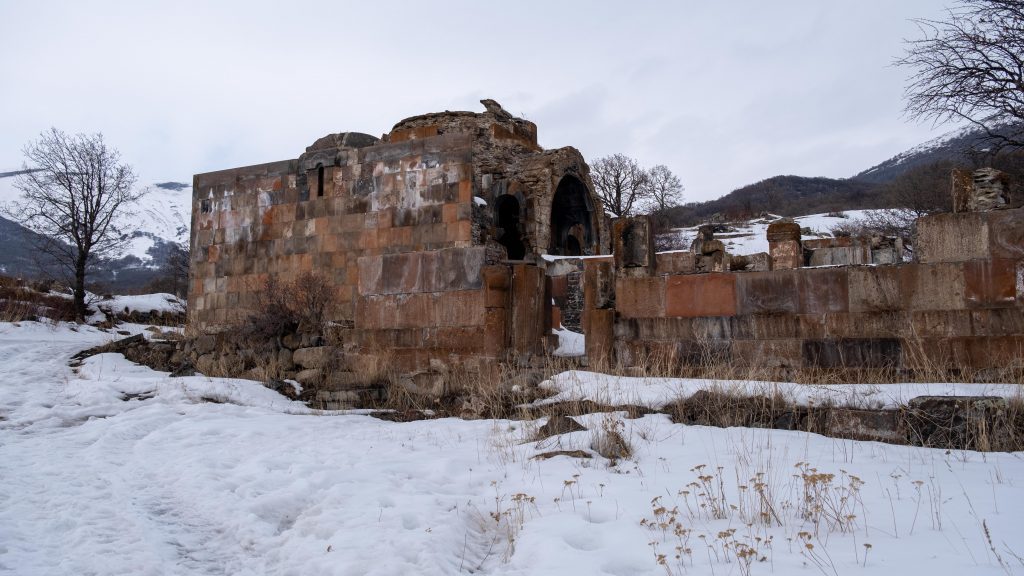
The only way to get to the ruins of the monastery is to hike the trail that leads up to it. You will be hiking on a moderate difficulty path that goes by a meadow that you can hear during the hike.
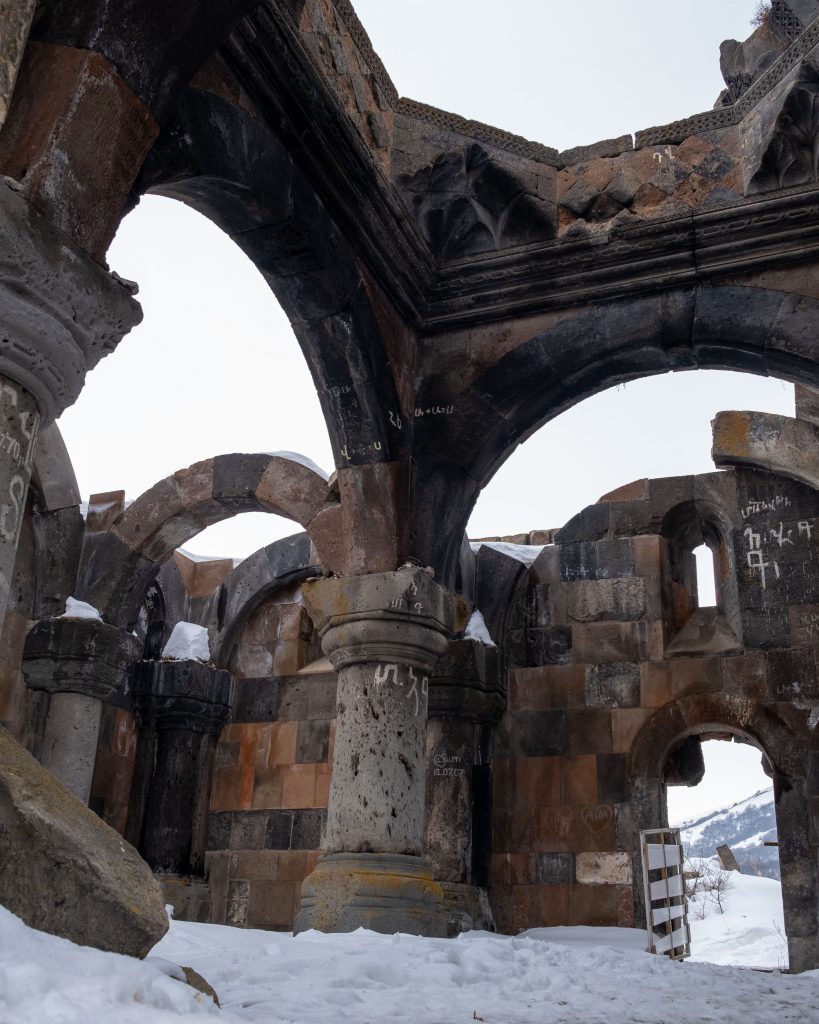
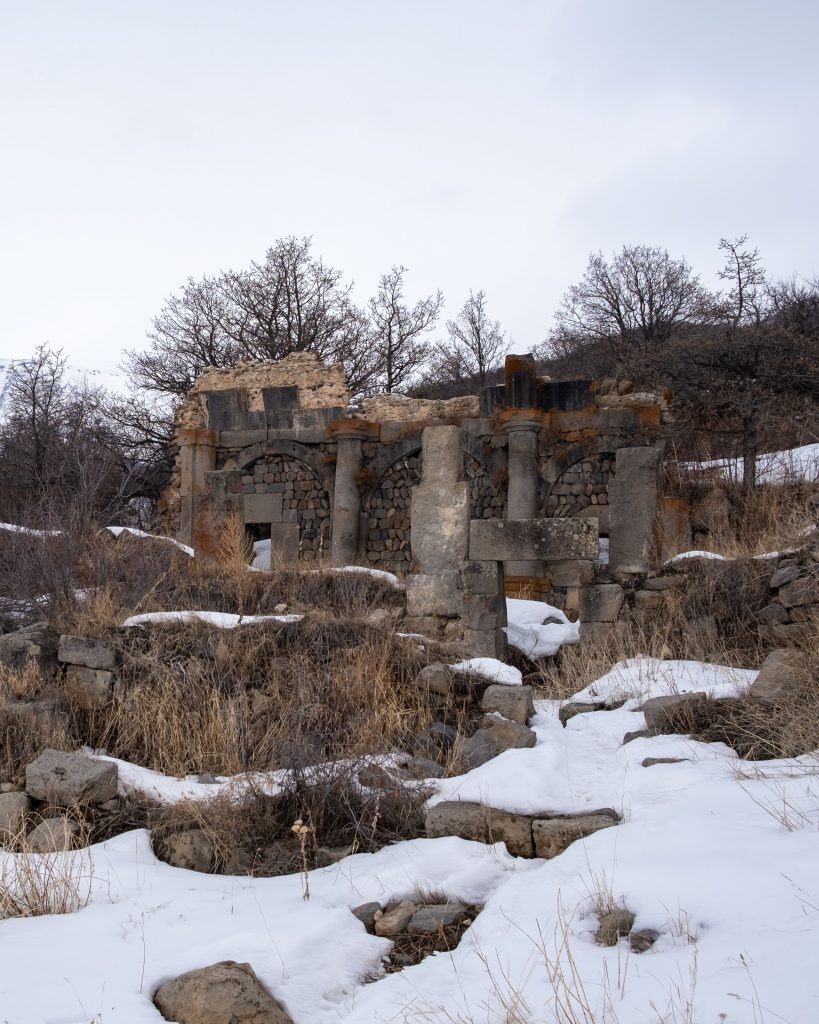
The monastery complex used to be a prominent cultural and scholastic center, but today, there are only the ruins remaining. This includes the ruins of the ancient small transept St. Astvatsatsin church which dates to the 6-7th centuries. It was discovered during excavations. There are also the ruins of Katoghike church that date to the 12th century, and which are located about 30 meters from St. Astvatsatsin church.
Churches to visit in Artsakh
Some may argue that Artsakh is not part of Armenia, but we beg to differ. Artsakh has been inhabited by Armenians for generations, and it was only when the maps for the post-Soviet Union were drawn that this beautiful plot of land was given to Azerbaijan. Today, the Republic of Artsakh is a de facto independent country in the South Caucasus.
If you are in Armenia, we strongly urge you to visit Artsakh. It is safe to go to, you just need to get a visa ahead of time, and you’re all set! When you’re there, there are 2 main churches to visit… One of which is unfortunately under Azeri rule for the moment.
16. Gandzasar monastery, the impressive mountaintop church
Welcome to Gandzasar monastery! This church is still located in Artsakh, safe from the destruction of Azerbaijan.
Built between the 10th to 13th centuries, this monastery in the Mardakert district of Artsakh. The monastery holds relics believed to belong to St. John the Baptist and his father St Zechariah. It’s also the seat of the Archbishop of Artsakh appointed by the Mother See of Holy Etchmiadzin.
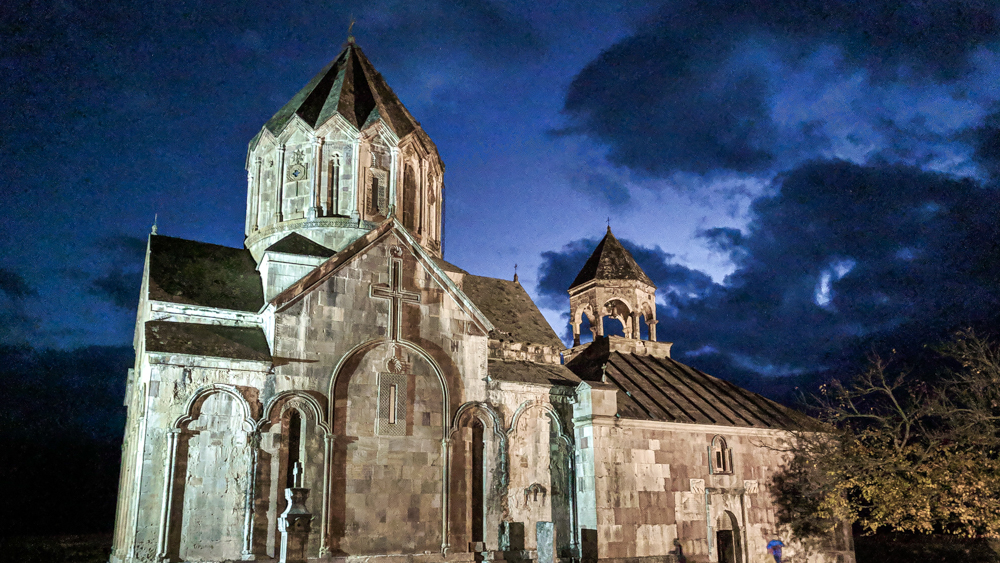
“Gandzasar” actually means treasure mountain or hilltop treasure in Armenian. It’s probably because it really does look like a treasure atop the hill. The surrounding mountains and valleys are also a beautiful sight to see… just don’t make the same mistake as us and go when it’s still light out!
17. Ghazanchetsots, a jewel of an Armenian church, lost to Azerbaijan
Ghazanchetsots is in Shushi and used the seat of the Diocese of Artsakh. Although the cathedral was recently rebuilt, it is quite a historic place. They started building the cathedral in 1868 and it was consecrated 20 years later, in 1888.
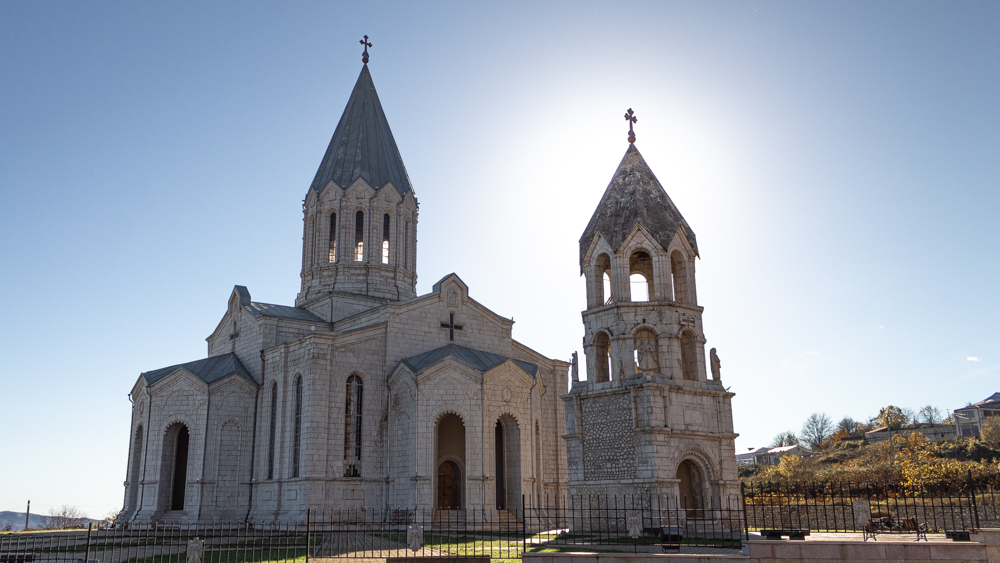
During the 1920 massacre of the Armenians, it was heavily damaged and it only fell into a decline in the following decades. Then, during the Nagorno-Karabakh War in the 1990’s, Azerbaijan used the cathedral as an armory, knowing Armenians would never attack a church. When the Armenians won the war, they restored to its current glory in 1998.
At 35 meters (115 ft) high, Ghazanchetsots is one of the largest Armenian churches in the world. It’s also a beacon of hope and a beloved landmark of Shushi and Artsakh.
During the most recent 44-day war between Artsakh and Azerbaijan, the latter actually attacked this church twice. It has been recognized as many as a war crime, as the church is not near any military bases, and at the time of the attack, the church was full of civilians and reporters.
Today, the church, and Shusi, have been lost to Azerbaijan, but there is hope that this historically Armenian land will be returned to Armenia soon enough.
What to expect when you visit Armenian churches
There are a few things to expect when visiting churches in Armenia. First, expect to be blown away by the architecture, and the surrounding area. Next, expect to see some crowds, as the churches in Armenia are some of the most important attractions in the country.
You can also expect to see a wedding. There will be crowds, extravagant outfits, beautiful wedding dresses, and unique men’s outfits. They may also sacrifice a sheep in honor of the wedding part.


Finally, expect to see old ladies selling food, as in, delicious homemade food, at the entrances (or exit) of churches. At almost every major church in Armenia, you can expect to find stall after stall of ladies selling bread, gata (a sweet Armenian treat), sujukh (walnuts dipped in grape jelly), dried fruits, honey from their own hives, apples from their orchard, and so much more.

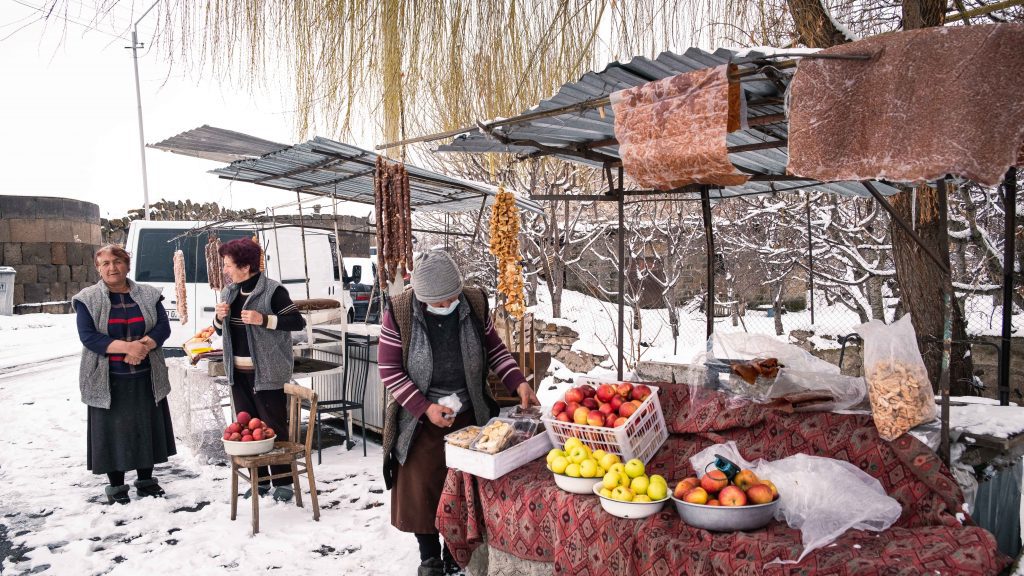
Another thing you can expect is that these ladies will try to feed you their treats so you buy from them. Refusing would be rude! And, if you can afford it, not that their goods are expensive, but we highly recommend you buy some treats from these ladies. Often, this is their only source of income and every little bit helps them.
Where to stay in Armenia
If you’re ready to crash after all these churches in Armenia, you can head to one of the many hotels available. There’s something for every budget and preference. You can also find homestays or try Couchsurfing. Whatever you choose, you’ll find a comfy place to get some rest so you can head back out and explore some more.
How to get around Armenia
There are a ton of ways to get around the country. Within cities, you can choose to walk, which is our favorite way of getting around.
If not, to get to most of these churches, you can hire a car off the GG app to cover longer distances. There are also marshrutkas and buses that run around Armenia. If you’re looking for other ways to get around this small country, make sure you check out our article here.
Armenian churches you have to visit
Here are the most beautiful cathedrals, monasteries and churches to visit in Armenia:
- Khor Virap Monastery
- Noravank Monastery
- Geghard Monastery
- St Grigor Lusavorich cathedral
- Katokhike church
- Surp Hovannes Mkrtich church
- Tatev Monastery
- Etchmiadzin Armenian Apostolic Church
- Sevanavank Monastery
- Hayravank Monastery
- Haghartsin Monastery
- Ohanavank church
- Saghmosavank church
- Holy Saviors’ Church
- Teghanyats monastery
- Gandzasar monastery
- Ghazanchetsots
Sustainable travel and ecotourism in Armenia
As always, we want to be sure everyone practices sustainable travel in Armenia, and all over the world. That’s why we always share these tips to help you travel in the most eco-friendly way possible! Ecotourism is so important because it helps lower our carbon footprint, it helps travel become less of a burden on the environment, and it helps preserve our beautiful planet, so future generations can explore the beauty of the world.
Here are our tips to help you practice sustainable travel in Armenia:
- Bring reusable water bottles and coffee mug: Tap water in Armenia is safe to drink, and it’s one of the cleanest in the world. So make sure you bring a reusable water bottle that you can fill up (we always have our Lifestraw Go with us!). You will also find freshwater fountains (called pulpulaks) all over Armenia. You can drink from there, or refill your bottle. And if you love to drink coffee, make sure you bring your reusable coffee mug too! This is the best way to reduce your plastic consumption and to sustainably travel all over the world!
- Eat as local and vegan as you can: This is the easiest way to reduce your environmental footprint. Eat as much local produce and food as possible, and especially, eat all the vegan options you can! It’s a delicious and easy way to reduce your carbon footprint.
- Support small local restaurants and eateries: If you eat out, make sure you go to locally-owned restaurants. Avoid big chains or restaurants owned by conglomerates. Go off-the-beaten-path with your restaurant choice by asking locals for their best recommendations. If you’re looking for the best restaurants in Yerevan, we’ve got you covered here.
- Bring your own bags and refuse plastic bags: Like most places, they still offer plastic bags in grocery stores, at the local markets, and at various shops. So bring your own bag and do your little step to promote ecotourism in Armenia and to save our beautiful planet!
- Walk around: We walked all around Armenia’s cities and towns. We had a great time getting lost in the streets. It helped that our hotels were so centrally located to all the main attractions.
- Use public transportation to get around the cities in Armenia: The subway in Yerevan is great, and most cities have their own bus system, which is chaotic but in an organized way. It’s very easy to get around the cities using public transportation.
- Take the bus or train to get from city to city in Armenia: Another great way to cover long distances in Armenia, if you’re traveling from town to town, is to use the buses or the train.
- Stay in eco-hotels or small locally-owned hotels in Armenia: Another great way to promote ecotourism in Armenia is to stay in smaller, locally-owned hotels, or better yet, to stay in eco-hotels. There are a ton of great options available, so make sure you check these options first!
Although these may seem like small steps, they will make a huge impact in the long run, especially considering that tourism in Armenia is constantly growing!
There are a ton of other beautiful churches to visit in Armenia. Seriously, a ton! From Zvartnots to Goshavank, Vahramashen, and Sanahin, the list goes on and on! Depending on your style of travel and what you like to see, you can easily cross a few of these off your bucket list, as most are easy to get to.
Have you been to Armenia? What were your favorite churches to see? Let us know in the comments.
We put a lot of time and effort into the content we create. Please like, comment and share, every action on your part helps us out tremendously and is very much appreciated.
You can also help us by pinning it for others to find.




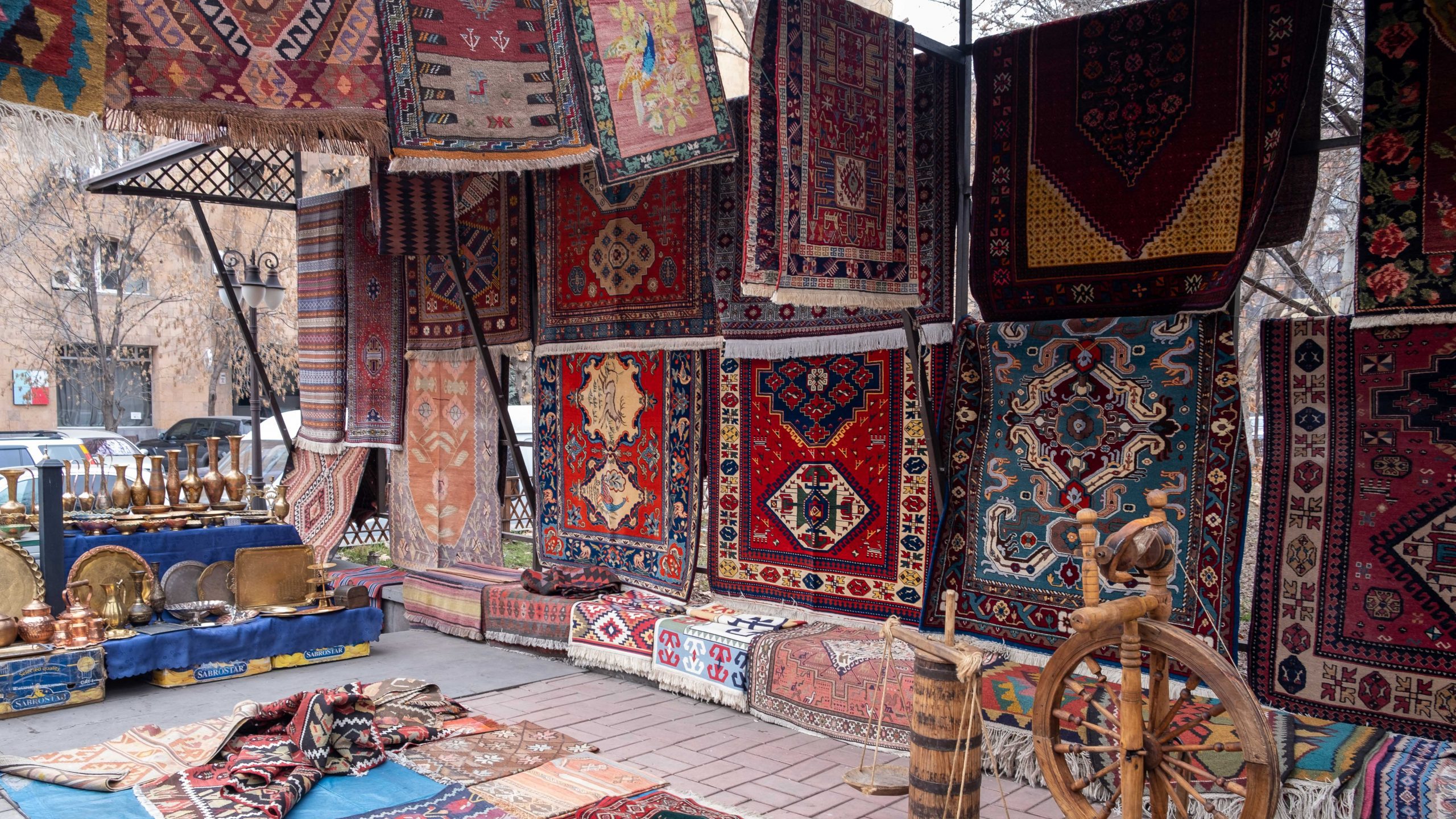
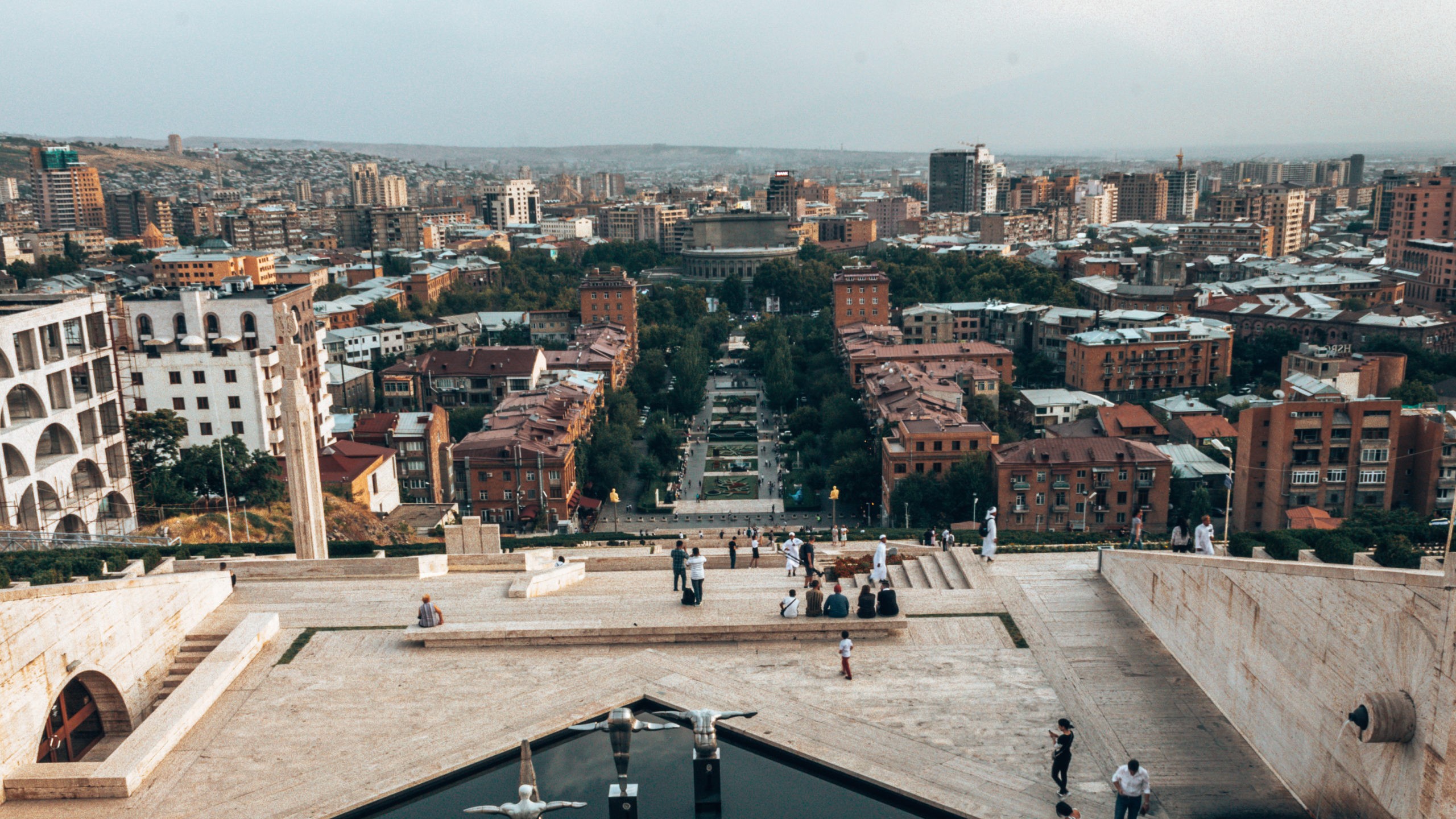




I love the way the local stone reflects the landscape. It’s almost like the churches grew out of the very earth, a beautiful idea. 🙂
Please also mention St Hripsime church, on the outskirts of Echmiatsin. This tetraconch church is one of the most important survivors from Armenia’s 7th century golden age, and a beautiful illustration of the sophistication of Armenia’s stone builders that had a profound effect on church building throughout Eurooe.
We will be sure to visit it next time we’re in Armenia and add it to our list. Thanks for letting us know about it!